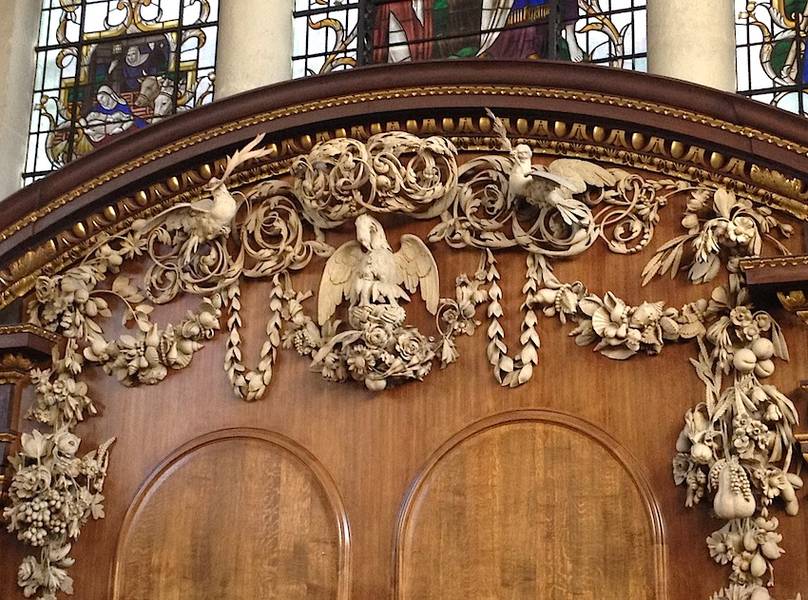In March 1986, a disastrous fire swept through the royal palace of Hampton Court. Started by an overturned candle in the grace and favour apartments on the top floor, it did enormous damage to the apartments below that had been built for King William III at the end of the 17th century. Among the decorations of these apartments was a superb set of carvings by Grinling Gibbons, the greatest of the English sculptors in wood.

Across the Atlantic the news filtered through to David Esterly, also a carver in wood, but rare among his contemporaries in that he specialised in the same type of flamboyant and intricate carving that was the hallmark of Gibbons’ work. He feared the worst, the total destruction of the carvings, and was relieved to hear that, despite much damage, only one seven-foot drop that had graced the side of a door had been totally lost. The others could be repaired but this one had to be recreated from new.
Esterly won the commission to create the new work and this is his finely written and meditative account of the journey to its completion. He had come to carving late, after years of academic study of literature that had focused on the relationship between the poet Yeats and the 3rd-century mystic philosopher Plotinus. A chance visit, when he was thirty, to the wonderful altar carving by Gibbons in St James’s Piccadilly (image above) transported him to the ‘still centre of the universe’ and a new course for his life was set.
A carver needs wood, from the linden tree, or limewood as it is normally known, a set of tools and his or her own skills. The relationship between the three is constantly changing as the wood, at first so vulnerable to direct attack, tries to craft its own patterns against the power of the tools and their master. So carving is never dull and Esterly works longer and longer hours in the room designated to him and his co-workers in the palace. His studies of Plotinus alerted him to the possibilities of a perfection that transcended what his own efforts were shaping and so this is indeed a meditation into the core of creativity. One mark of perfection is to carve what cannot be seen to the same quality as what can be seen as if the invisible permeates the visible and so leads to a yet higher excellence. Esterly ridicules the conceptualism of Jeff Koons, who can imagine an idea in wood and then commission inept carvers (Esterly wonders whether they carved so badly as a deliberate prank) to shape it before an undiscriminating buyer parts with nearly six million dollars to own the finished article.
There are other stories running alongside the patient work of recreation: the inevitable bureaucratic conflicts, the decision whether to leave the new work as it would have been created by Gibbons or whether to match the colour to the remaining carvings. Had Gibbons used any form of sandpaper to finally smooth his work? The conventional view had been that he had not—but then what were those parallel striations which could be seen close up? The combined expertise of the Victoria & Albert and Natural History Museums finally brings up ‘Dutch rush’, a plant that incorporates silica on its stems and which once dried can indeed be used as sandpaper. An experiment shows that the striations match perfectly and a new understanding of Gibbons’ methods has emerged.
The Lost Carving reminded me of Orhan Parmuk’s My Name is Red, where his 16th-century miniaturists debate whether the end of their art is to achieve the perfection of their forbears or to risk evolving new forms. A phrase from an ancient Egyptian text also returned to me: ‘Take counsel with the ignorant as with the wise, for the limits of excellence cannot be reached and no artist fully possesses, his skill’. Esterly, sensitive as he is to the mystery of beauty, would certainly drink (a pint of Adnams Mild at the King’s Arms by the Lion Gate of Hampton Court) to that.
Reviewed by Charles Freeman, historical consultant to the Blue Guides. To read more about Hampton Court (as well as Charles Freeman’s own account of Eton College), see Blue Guide London.
The Lost Carving: A Journey to the Heart of Making published by Duckworth is the UK, Viking / Penguin in the US is now out in paperback.






